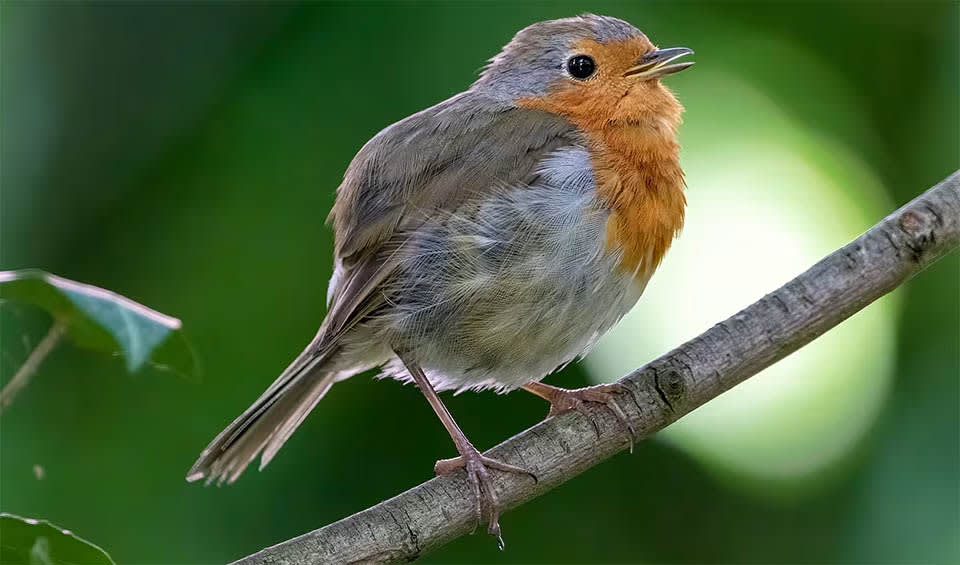A small, charismatic bird instantly recognizable due to its bright orange-red breast and face set against a grey-brown body. This little bird is common across Europe, extending into parts of Western Asia and North Africa. Robins are beloved in many cultures, particularly in Britain, where they symbolize Christmas.
One of the European Robin’s most distinctive traits is its melodious singing voice. Robins are among the few UK birds that sing year-round, as males fiercely defend their territory with their song during and outside the breeding season. The song, usually a sweet, warbling tune, is most prominent during the early morning and late evening and is often described as a liquid and soothing sound. Interestingly, robins are known to sing at night under artificial light, making them one of the few birds that can be heard in urban environments after dark.
Robins are unusually interactive with humans compared to other wild birds. They can quickly become accustomed to human presence, and it’s not uncommon for them to approach people gardening to forage for any disturbed worms. This boldness around humans has endeared them to many, often being portrayed as the gardener’s friend.
A fun fact about the European Robin is its prominence in British folklore and culture. It has been a symbol of good luck and was even voted the UK’s national bird in a public poll in 2015. The robin frequently appears on Christmas greeting cards and decorations, a tradition believed to have begun in the 19th century when postmen, who delivered cards, wore red tunics and were nicknamed “Robins.”
Distribution
 Afghanistan
Afghanistan Albania
Albania Algeria
Algeria Andorra
Andorra Armenia
Armenia Austria
Austria Azerbaijan
Azerbaijan Bahrain
Bahrain Belarus
Belarus Belgium
Belgium Bosnia And Herz.
Bosnia And Herz. Bulgaria
Bulgaria China
China Croatia
Croatia Cyprus
Cyprus Czechia
Czechia Denmark
Denmark Egypt
Egypt Estonia
Estonia Faroe Islands
Faroe Islands Finland
Finland France
France Georgia
Georgia Germany
Germany Gibraltar
Gibraltar Greece
Greece Hungary
Hungary Iceland
Iceland Iran
Iran Iraq
Iraq Ireland
Ireland Israel
Israel Italy
Italy Japan
Japan Jordan
Jordan Kazakhstan
Kazakhstan Kuwait
Kuwait Kyrgyzstan
Kyrgyzstan Latvia
Latvia Lebanon
Lebanon Libya
Libya Liechtenstein
Liechtenstein Lithuania
Lithuania Luxembourg
Luxembourg Malta
Malta Mauritania
Mauritania Moldova
Moldova Montenegro
Montenegro Morocco
Morocco Netherlands
Netherlands North Macedonia
North Macedonia Norway
Norway Oman
Oman Poland
Poland Portugal
Portugal Qatar
Qatar Romania
Romania Russia
Russia Saudi Arabia
Saudi Arabia Serbia
Serbia Slovakia
Slovakia Slovenia
Slovenia Spain
Spain Svalbard
Svalbard Sweden
Sweden Switzerland
Switzerland Syria
Syria Tajikistan
Tajikistan Tunisia
Tunisia Turkmenistan
Turkmenistan Turkey
Turkey UAE
UAE Ukraine
Ukraine United Kingdom
United KingdomAnything we've missed?
Help us improve this page by suggesting edits. Glory never dies!
Suggest an editGet to know me
Terrestrial / Aquatic
Altricial / Precocial
Polygamous / Monogamous
Dimorphic (size) / Monomorphic
Active: Diurnal / Nocturnal
Social behavior: Solitary / Pack / Herd
Diet: Carnivore / Herbivore / Omnivore / Piscivorous / Insectivore
Migratory: Yes / No
Domesticated: Yes / No
Dangerous: Yes / No




